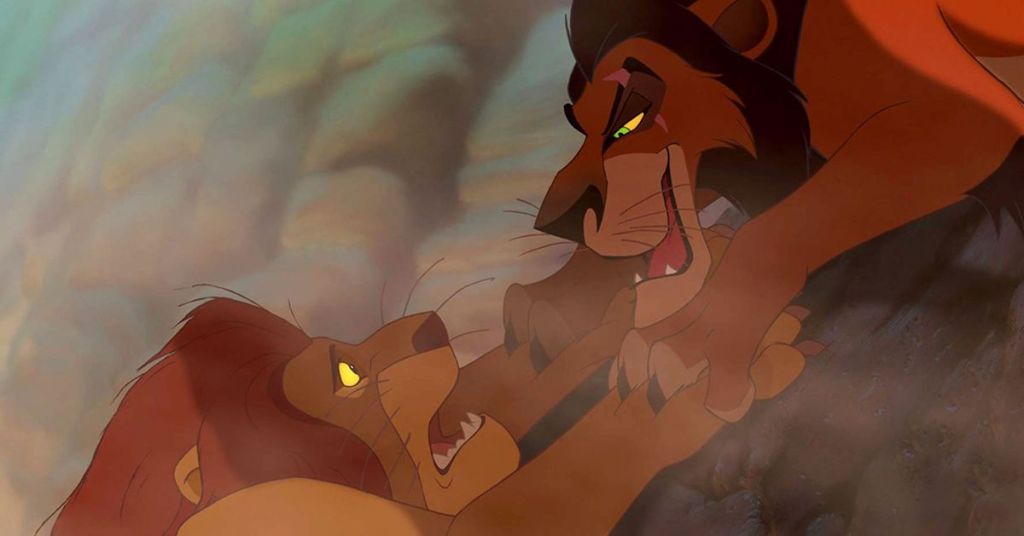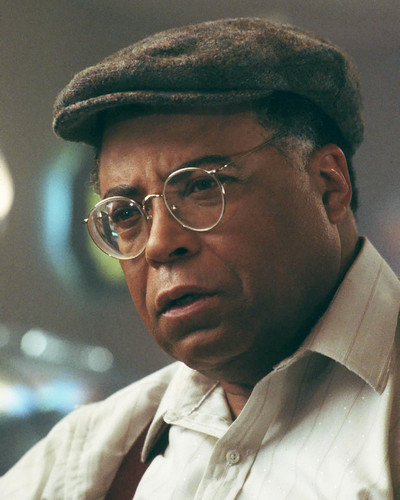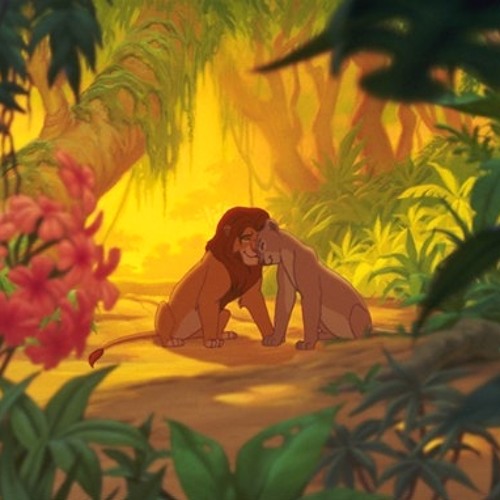
I’ve said it before but the animated musical The Lion King is my favorite Disney film of all time. I can even confidently say that when it comes to my favorite films of all time, this one holds third place behind Star Wars and Finding Nemo (admittedly both of those are owned by Disney but Lucasfilm and Pixar created them). And while I’ve talked about The Lion King many times in the past, I’ve never dedicated an entire article to the film so that I can really explain why I love it so much.
Spoilers ahead as I describe the plot: The story of the film centers on a lion cub named Simba whose father Mufasa, the king of the Pride Lands, is killed in a wildebeest stampede, which leads to Simba running away from home and his uncle Scar inheriting the kingdom. Simba runs far away and grows up in the jungle where he leaves his royal past behind him, but when an old friend tracks him down and he learns that Scar is destroying the kingdom and turning it into a wasteland, he finally decides to face his past and go back home to confront Scar and save the Pride Lands.




The film does an outstanding job introducing every single character in the film’s colorful cast, as well as using early plot elements to foreshadow important events later on (such as Simba’s romance with Nala) in ways that feel natural. The filmmakers set the film’s tone perfectly with the epic song “Circle of Life” sung by Carmen Twillie and Lebo M who memorably performed the film’s opening Zulu chant along with backup from his choir right when the sun rises on the very first frame of the film. The song plays at the same time the film’s main character is being introduced, both literally to the theater audience and to the animals in the Pride Lands, while simultaneously emphasizing one of the film’s most prominent themes.

The film instantly draws you in with the artistry, the music, the relatable characters, the emotional drama and most essentially for a family film like this, a consistent sense of fun, with a well-rounded sense of humor that anyone from kids to adults could enjoy from visual gags to witty dialogue (“He’d make a very handsome throw rug”) and it does a good job balancing the lighter moments with the darker moments, which is something that Disney’s best animated films have always done, but is particularly impressive here where they have managed to pull off a balancing act like no other, one minute featuring the most emotional death scene in animation history and another featuring a hula-dancing meerkat. The way this film is so well-written and well-acted that it can stir my emotions almost effortlessly reminded me of classic films like Dumbo or The Jungle Book. It’s just quality storytelling.

The origin of the film began in 1988 when Roy E. Disney and Walt Disney Feature Animation vice president for creative affairs Charlie Fink met with sci-fi author and The Brave Little Toaster creator Thomas Disch to discuss the idea of creating an animated Bambi-type drama set in the jungle. Within a month, Disch came back with a nine-page treatment for a movie called King of the Kalahari. Since then, multiple writers at Disney have added to the script with their own treatments throughout the late eighties, while changing the film’s name to King of the Beasts and then King of the Jungle before the story shifted from the jungle to the savannah and eventually became The Lion King.

The original directing team consisted of Oliver & Company director George Scribner and Beauty and the Beast story lead Roger Allers, who both worked on the script for The Lion King with Beauty and the Beast screenwriter Linda Woolverton and were later joined by Brenda Chapman, Chris Sanders and Lisa Keene. This crew would visit Kenya to study the wildlife for inspiration as they tried to flesh out the story. Although Scribner left the project after six months of story development when it became clear that his creative vision for a realistic nature documentary-like approach would not be compatible with the musical direction that the film was heading in, and so Scribner was replaced in 1992 by animator Rob Minkoff, who had previously directed a couple of Roger Rabbit shorts and who ironically co-wrote a song for a film that George Scribner directed: “Good Company” for Oliver & Company.

After Beauty and the Beast producer Don Hahn joined the film as a producer, he met up with the story team and sharpened the film’s inconsistent focus and made the story’s message more clear, one of growing up and facing responsibility. Out of those meetings, the story crew made Mufasa and Scar brothers, came up with the idea for Mufasa to return as a ghost, and made Rafiki less serious and more comical, while Disney executives Michael Eisner and Jeffrey Katzenberg encouraged the team to lean more into the Shakespearean themes, although in addition to Hamlet, the crew also looked to the Bible and the stories of Joseph and Moses for inspiration.

After Linda Woolverton left the project to work on the stage adaptation of Beauty and the Beast, San Francisco-born TV writer Irene Mecchi and television producer Jonathan Roberts (who worked on the short-lived Fast Times sitcom before co-producing Beverly Hills 90210) were brought in to polish the script, including adding more comedic moments for Timon, Pumbaa and the hyenas.

As for the voice cast, Jonathan Taylor Thomas, who was best known for playing Randy Taylor in the ABC sitcom Home Improvement, was cast as the voice of the young Simba while WarGames and Ferris Beuller’s Day Off star Matthew Broderick was cast as the adult Simba. James Earl Jones was chosen to play Mufasa for his vocal gravitas while other recognizable performers included Shakespearean theater actor Jeremy Irons as the villain Scar, TV star Robert Guillaume of Benson fame as the baboon shaman Rafiki, Moira Kelly (The Cutting Edge, Twin Peaks: Fire Walk with Me) as the adult Nala, Madge Sinclair (Roots, Coming to America) as Simba’s mother Sarabi, British comedian Rowan Atkinson (Blackadder, Mr. Bean) as Zazu the majordomo hornbill, Tony-nominated Broadway actor Nathan Lane as meerkat outcast Timon and theater and TV star Ernie Sabella as Timon’s warthog companion Pumbaa (Lane and Sabella both initially auditioned for the roles of two hyenas, but the filmmakers loved their chemistry so much they decided to utilize their comedic talents for the roles of the film’s central comic relief duo instead). Meanwhile the hyenas Shenzi, Banzai and Ed were brought to life by the vocals of Whoopi Goldberg, Cheech Marin (Tommy Chong was unfortunately unavailable to voice a hyena alongside Cheech) and Jim Cummings, a veteran voice actor who was already known around Disney as the voice of Pete, Darkwing Duck, Winnie the Pooh and others (including the singing voice of Scar in this movie).




While many of Disney’s best animators were working on Pocahontas because they believed that film sounded better than the talking lion movie, this was no B-team. Young Simba would be supervised by Jasmine animator Mark Henn while Ursula animator Ruben Aquino handled Simba as an adult, Andreas Deja (Jafar) supervised Scar and James Baxter (Roger Rabbit, Belle) supervised Rafiki while Tony Fucile handled Mufasa, Anthony DeRosa handled Nala as an adult, Ellen Woodbury handled Zazu, Michael Surrey handled Timon and Tony Bancroft handled Pumbaa. Other great animators who worked on the film include Dale Baer, Tom Bancroft, Russ Edmonds, Randy Haycock, Alex Kupershmidt, James Lopez, David Pruiksma and Aaron Blaise. The animation team would be facing a new challenge working on a film consisting primarily of animal characters who needed to move like real animals with only subtle anthropomorphic qualities, but they got a lot of help from zoo animals that were brought into the studio (similar to how deer were brought into the studio to aid animators during the production of Bambi while borrowing the same human-like animal design philosophy).


Incidentally this would not be Jeffrey Katzenberg’s last encounter with a real-life lion.

And while all this research was happening in the animal kingdom, the animators still found time to break technological ground. For example, the memorable wildebeest herd was brought to life through computer animation (cel-shaded to help them fit into the hand-drawn world of the movie) that was programmed to artificially behave in a way that would prevent them from crashing into the other wildebeests as they charged down the hill and into the gorge. Something that may have topped the Beauty and the Beast ballroom scene and Aladdin’s Cave of Wonders in terms of CG spectacle.

Aladdin lyricist Tim Rice was invited to write songs for The Lion King, but Alan Menken was unavailable to join him so Rice suggested that Disney hire Elton John to compose the songs. Elton John was not only a Disney fan but he also found appeal in the idea of writing songs that both kids and adults could enjoy. He and Tim Rice nailed the assignment with their five songs: “Circle of Life,” “I Just Can’t Wait to Be King,” “Be Prepared,” “Hakuna Matata” and “Can You Feel the Love Tonight,” which are all very different from each other but all outstanding, with Hans Zimmer contributing some of his best work on the score in collaboration with Lebo M (who worked previously with Hans Zimmer on the 1992 film The Power of One), adding significantly to the film’s emotion and African-influenced rhythmic style. To this day it is still my favorite movie soundtrack and one that still gives me the same amount of joy I felt the first time I heard it.




I’ll never forget the sheer hype and anticipation I felt leading up to the release of this movie when I was five years old, especially following Disney’s smart decision to release the entire “Circle of Life” opening sequence as the film’s official trailer, which only made people like me even more curious about the film. And after some positive buzz followed the premieres at El Capitan in L.A. and Radio City Music Hall in NYC, the film was released in the summer of 1994 to huge critical acclaim and commercial success, becoming one of the most popular films of all time as well as the highest-grossing film of 1994 and the highest-grossing animated film of all time, holding onto that title until Finding Nemo came out in 2003, although it remains the highest-grossing traditionally animated film and the best-selling film on home video. And not only was it popular with audiences and critics but it got love from the Academy as well, winning two Oscars for Hans Zimmer’s score and for Tim Rice and Elton John’s song “Can You Feel the Love Tonight” (“Circle of Life” and “Hakuna Matata” were also nominated). It did however manage to win the Golden Globe for Best Motion Picture – Comedy or Musical. And on top of all these accolades, the film is regularly considered one of the best animated films of all time, up there with Snow White and the Seven Dwarfs, Pinocchio, Bambi and Beauty and the Beast.

The Lion King was such a pop culture phenomenon that it has continued to be adapted and referenced in the decades since across film, television, stage, games, theme parks and merchandise around the world, including the sequel The Lion King II: Simba’s Pride, a television spin-off starring Timon and Pumbaa, a Disney Junior series that takes place within the time gap in The Lion King II, Julie Taymor’s 1997 stage musical adaptation (which has also received worldwide acclaim), theme park attractions like Epcot’s Circle of Life: An Environmental Fable and the Festival of the Lion King to name a few. But none of these things I love as much as that original film from 1994, which I think is one of Hollywood’s crowning achievements and thematically, artistically and narratively the quintessential Disney film because viewers of all ages will come away from the experience of watching that movie with something valuable.

